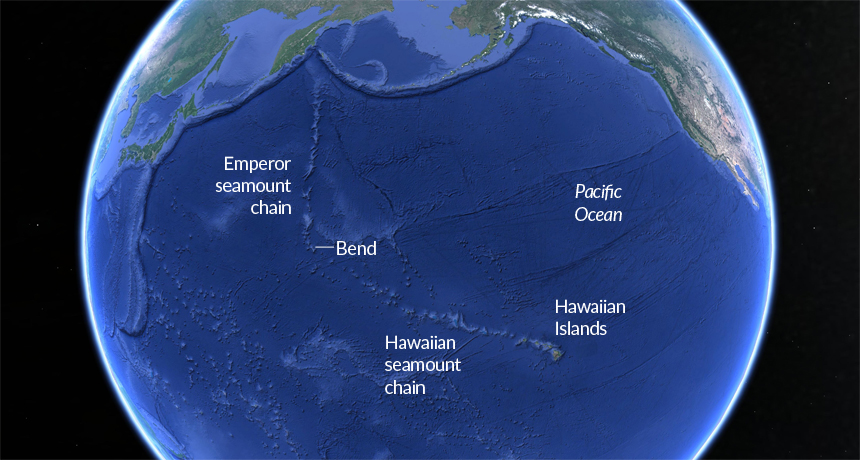Plate loss gave chain of Pacific islands and seamounts a bend
Shift in mantle flow repositioned magma plume responsible for Hawaii

SHARP TURN The sharp bend in the Hawaiian-Emperor seamount chain formed after a sinking tectonic plate redirected the mantle flowing underneath the Pacific Ocean, new research suggests.
Google Earth Pro
- More than 2 years ago
The disappearance of a tectonic plate into Earth’s interior may be responsible for the distinctive bend in the chain of underwater mountains and islands that includes the Hawaiian archipelago.
A reconstruction of the mantle flowing under the Pacific Ocean about 50 million years ago suggests that the submergence of the Izanagi Plate near East Asia reversed the flow’s direction. This mantle U-turn could have immobilized the mantle-dwelling plume of magma that built the mountain ranges, the researchers report online March 24 in Geophysical Research Letters. The abrupt stop probably caused the roughly 120-degree kink in the Hawaiian-Emperor seamount chain as Earth’s crust moved westward over the plume, they conclude.
Scientists had previously thought a sudden shift in the Pacific Plate’s movements over the magma-spewing hot spot produced the bend where the Emperor undersea mountain range connects to the Hawaiian one. In a related paper published online March 27 in Geology, researchers calculate that the plate didn’t significantly alter course around the time the seamount chain got bent.
The two findings together suggest that the bend’s initial origin story was off the mark, says geodynamicist Lijun Liu of the University of Illinois at Urbana-Champaign. “These two papers might actually resolve this longstanding debate,” he says. “These are two powerful, independent pieces of evidence that the Hawaiian-Emperor bend is an indication of a deep mantle process, rather than a surface plate motion.”
The Hawaiian hot spot is a tube-shaped plume in the mantle that carries magma from near Earth’s core to the surface. Over more than 80 million years, molten rock from the hot spot built up a mountain range of islands and underwater seamounts stretching more than 5,800 kilometers across the Pacific Ocean. The seamount chain grew south at first before abruptly turning east around 50 million years ago.
About 10 million years before the seamount chain took a turn, a tectonic plate off the coast of East Asia met its doom. The Izanagi Plate completely slipped under another plate and into the mantle. Geodynamicist Maria Seton of the University of Sydney and colleagues wondered how the plate’s plunge impacted the movement of mantle beneath the Earth’s surface. Prior to the plate’s demise, the sinking rocky slab had acted like a wall in the mantle layer, obstructing the mantle flow.
Simulating the interactions between the mantle and the sinking plate, the researchers calculated that removal of the mantle-blocking Izanagi Plate triggered a 7-million-year reorganization of mantle movements beneath the Pacific. Mantle flows did an about-face in the simulation, switching from a southward flow at a rate of 0.5 to 1.7 centimeters per year to a slower northward to northwestward flow of 0.1 to 1.1 centimeters per year. Because the Hawaiian hot spot sits within the mantle, the reversed mantle flow halted the hot spot’s southward drift but wasn’t strong enough to push it northwestward. The hot spot remained stationary as the Pacific Plate drifted westward over it. As a result, the Hawaiian seamount chain expanded to the east.
In the separate study, geoscientist Nicky Wright of the University of Sydney and colleagues including Seton used geological data to retrace the Pacific Plate’s movements going back tens of millions of years. They show that while the Izanagi Plate’s disappearance ultimately caused the Pacific Plate to shift more westward, this process was too slow to account for the sharp Hawaiian-Emperor bend.
“For the longest time scientists assumed that this prominent bend formed because the Pacific Plate changed direction,” says geophysicist Dietmar Müller of the University of Sydney, who coauthored both studies. “We now can demonstrate that the mantle, not the plate, changed its direction of motion.”
Editor’s note: This story was updated on April 10, 2015, to correct the direction of the mantle flow shift. Mantle flows shifted north-northwestward, not northeastward.







